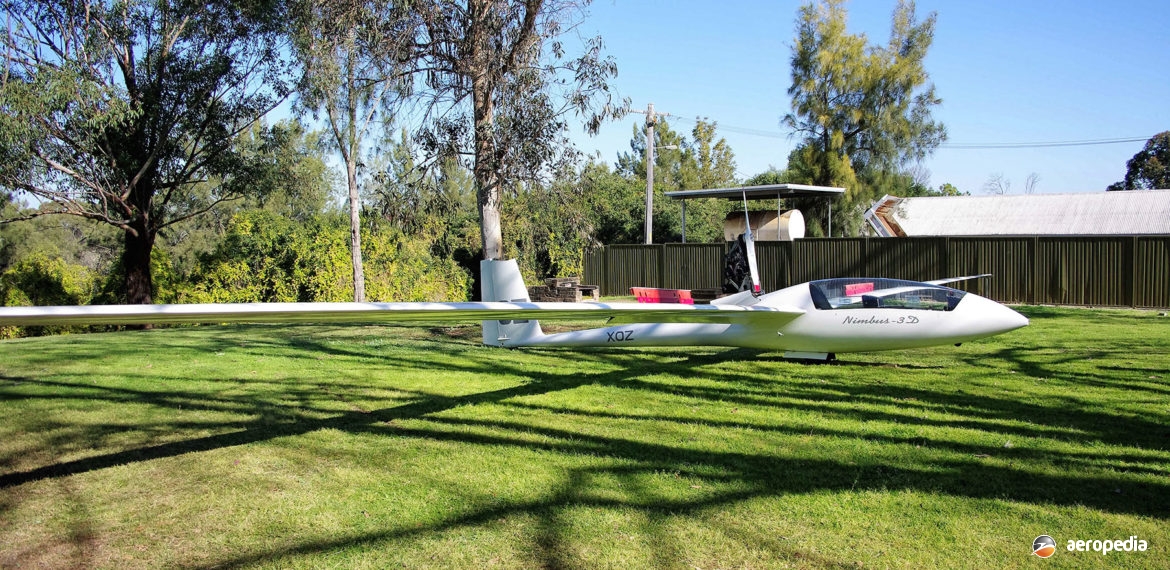Photograph:
Schempp-Hirth Nimbus 3DM VH-XOZ (c/n 20) at Camden, NSW in August 2009 (David C Eyre)
Country of origin:
Germany
Description:
Single-seat self-launched glider
Power Plant:
One 44 kw (60 hp) Rotax 535C two-cylinder, two-stroke, 521.2 cc (31.8 cub in) engine
Specifications:
- Wingspan: 26.5 m (87 ft)
- Length: 7.83 m (25 ft 8 in)
- Height: 1.55 m (5 ft 1 in)
- Wing area: 17.86 m² (192.24 sq ft)
- Max speed: 285 km/h (177 mph)
- Cruising speed: 142 km/h (88 mph)
- Range: 3,008 km (1,869 miles)
- Max glide ratio: 60:1
- Rate of sink: 22.8 m/min (75 ft/min)
- Empty weight: 595 kg (1,312 lb)
- Loaded weight: 820 kg (1,808 lb)
History:
The Nimbus series of gliders over the years produced by Schempp-Hirth in Germany, and designed by Klaus Holighaus, has been very popular. It has been produced in a range of variants, a number having sustainer engines, and others being fitted with Rotax engines which are able to self-launch.
The first Nimbus-3 flew on 21 February 1981 and was similar to the Nimbus-2 but used a new wing profile, having a wing of 22.9 m (75 ft) which could be increased to 24.5 m (80 ft) or 25.5 m (83.6 ft) with tip extensions. A glide ratio of 10:1 was claimed. The Nimbus-3T had a sustainer engine. Nimbus-3s took the first three places in the Open Class in the 1981 World Gliding Championships. The Nimbus-3D was a two-seat variant, making its first flight in May 1986.
The Nimbus-4, like the earlier models, was built at the Company’s facility Flugzeugbau in Kirchheim, Germany and first flew in 1990. It was a direct derivative of the earlier models and by 2010 44 single-seat and 100 two-seat examples had been produced. The wing could be increased in span to 26.5 m (87 ft). The aspect ratio was 38.8. The manufacturer claimed the glider had a glide ratio of better than 60:1 at a speed of 110 km/h (68 mph) and thus could glide 60 km on course for every 1,000 metres of altitude lost in still air. Variants were produced with either turbo engines, which are known as the Nimbus-4T, or the self-launched model known as the Nimbus-4DM.
Construction was of fibre reinforced plastic with full-span flight controls and a T-tail. The engine was housed in the fuselage to the rear of the wing, an electrically driven spindle extending the propeller pylon upwards and forward from the engine bay. A Nimbus-4DM set a 500 km (310 miles) course record at a speed of 306.8 km/h (190.6 mph) in December 2006.
A number of Nimbus-3s have been operated in Australasia. Models in this series include the 3T with a self-sustaining Solo 2350 engine; and the 3MR a self-launched model with a Rotax 535B engine, which was first flown on 9 July 1983. Australian registered aircraft include: VH-GAA (c/n 6), VH-IHE (c/n 7) which crashed at Narrandera, NSW on 14 January 1988; VH-VJS (c/n 18); VH-IIX (c/n 27); VH-XJR (c/n 48); VH-XQE (c/h 74) and VH-ZBV (c/n ‘192’). VH-GFF was a Model 3T, was operated by the Bathurst Soaring Club, and was fitted with a sustainer engine.

